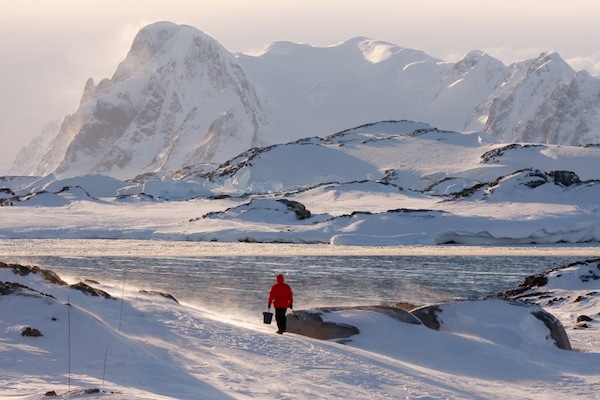Climate conundrum: Conflicting indicators on what preceded human-driven warming

A fisherman walks toward open water in the Antarctic ice sheet. Conflicting research on the heating and cooling of Earth has led to a global temperature conundrum, which climate scientists plan to address further this fall.
Photo: iStock Photo
When the Intergovernmental Panel on Climate Change recently requested a figure for its annual report, to show global temperature trends over the last 10,000 years, the University of Wisconsin–Madison’s Zhengyu Liu knew that was going to be a problem.
“We have been building models and there are now robust contradictions,” says Liu, a professor in the UW–Madison Department of Atmospheric and Oceanic Sciences and the Center for Climatic Research. “Data from observation says global cooling. The physical model says it has to be warming.”

Zhengyu Liu
Writing in the journal Proceedings of the National Academy of Sciences today, Liu and colleagues from Rutgers University, the National Center for Atmospheric Research, the Alfred Wegener Institute for Polar and Marine Research, the University of Hawaii, the University of Reading, the Chinese Academy of Sciences, and the University of Albany describe a consistent global warming trend over the course of the Holocene, our current geological epoch, counter to a study published last year that described a period of global cooling before human influence.
The scientists call this problem the Holocene temperature conundrum. It has important implications for understanding climate change and evaluating climate models, as well as for the benchmarks used to create climate models for the future. It does not, the authors emphasize, change the evidence of human impact on global climate beginning in the 20th century.
“The question is, ‘Who is right?’” says Liu. “Or, maybe none of us is completely right. It could be partly a data problem, since some of the data in last year’s study contradicts itself. It could partly be a model problem because of some missing physical mechanisms.”
They ran simulations of climate influences. Each shows global warming over the last 10,000 years.
Over the last 10,000 years, Liu says, we know atmospheric carbon dioxide rose by 20 parts per million before the 20th century, and the massive ice sheet of the Last Glacial Maximum has been retreating. These physical changes suggest that, globally, the annual mean global temperature should have continued to warm, even as regions of the world experienced cooling, such as during the Little Ice Age in Europe between the 16th and 19th centuries.
The three models Liu and colleagues generated took two years to complete. They ran simulations of climate influences that spanned from the intensity of sunlight on Earth to global greenhouse gases, ice sheet cover and meltwater changes. Each shows global warming over the last 10,000 years.
Yet, the bio- and geo-thermometers used last year in a study in the journal Science suggest a period of global cooling beginning about 7,000 years ago and continuing until humans began to leave a mark, the so-called “hockey stick” on the current climate model graph, which reflects a profound global warming trend.
In that study, the authors looked at data collected by other scientists from ice core samples, phytoplankton sediments and more at 73 sites around the world. The data they gathered sometimes conflicted, particularly in the Northern Hemisphere.
Because interpretation of these proxies is complicated, Liu and colleagues believe they may not adequately address the bigger picture. For instance, biological samples taken from a core deposited in the summer may be different from samples at the exact same site had they been taken from a winter sediment. It’s a limitation the authors of last year’s study recognize.
“In the Northern Atlantic, there is cooling and warming data the (climate change) community hasn’t been able to figure out,” says Liu.
“Both communities have to look back critically and see what is missing. I think it is a puzzle.”
Zhengyu Liu
With their current knowledge, Liu and colleagues don’t believe any physical forces over the last 10,000 years could have been strong enough to overwhelm the warming indicated by the increase in global greenhouse gases and the melting ice sheet, nor do the physical models in the study show that it’s possible.
“The fundamental laws of physics say that as the temperature goes up, it has to get warmer,” says Liu, also a professor of environmental studies in the Nelson Institute.
Caveats in the latest study include a lack of influence from volcanic activity in the models, which could lead to cooling — though the authors point out there is no evidence to suggest significant volcanic activity during the Holocene — and no dust or vegetation contributions, which could also cause cooling.
Liu says climate scientists plan to meet this fall to discuss the conundrum.
“Both communities have to look back critically and see what is missing,” he says. “I think it is a puzzle.”
The study was supported by grants from the (U.S.) National Science Foundation, the Chinese National Science Foundation, the U.S. Department of Energy, and the Chinese Ministry of Science and Technology.
Tags: climate change, environment, research




